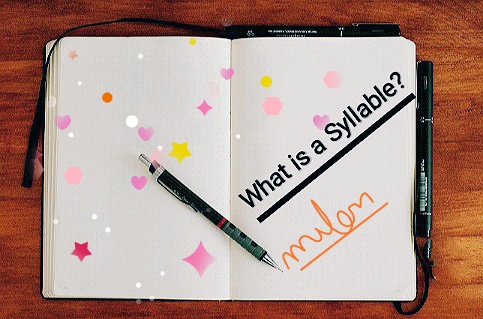What Is a Syllable in the English?
What is a syllable in English? A syllable is a unit of spoken language that constitutes an entire word or part of a word. Syllables are usually made up of a single vowel and any surrounding consonants. For example, the word 'butter' has two syllables: 'but' and 'ter'.
What is a Syllable?
A syllable is a continuous part of a word that opens and closes the mouth to form vowels. It consists of one or more letters with a vowel sound. This means that we hear a vowel in each syllable.For example, the words cat and boat have 1 syllable because we hear a vowel in each word. The words cupcake and dinner have 2 syllables, because we hear 2 vowels in these words.
So you see, it's not as simple as identifying the vowel in a word and using that number. Because sometimes 2 vowels make 1 sound, as in the word boat.
What is a Syllable in English? – Examples:
Since we asked 'What is a syllable in English?' Questions answered, so it's time for us to witness them in action. Below are some examples of words with different number of syllables:'Tie' has one syllable.
'Rescue' has two syllables - Res + cue
'Alphabet' has three syllables - Con + so + nant
'Activity' has four syllables - Ac + tiv + i + ty
'Electricity' has five syllables - E + lec + tri + ci + ty
A word consisting of only one syllable can be called monosyllabic. There are also names for other syllable combinations of words: disyllabic for two, trisyllabic for three, and quaternary for four. Or, you can refer to them as polysyllabic if they have more than one!
An important point to note is that the length of a word does not affect its number of syllables. It is all about the number of vowels.
How Many Syllables are in a Word?
A syllable begins with a vowel sound. That vowel is often combined with a consonant or consonant to form a syllable. Syllables sometimes have multiple vowels but never multiple vowels.Syllables create meaning in English language. Vowels and consonants combine to form sounds.
However, a single syllable makes a single sound. Some words have monosyllables, which means they have one syllable. Multiple sounds mean the word has more than one syllable.
What are the 6 Types of Syllables?
'What is a syllable in English?' In our journey of learning we will learn about different types of syllables. Although there are two main types of syllables, closed and open, there can be divided into six different types. Let's find out what they are:- Closed syllable
- Open syllable
- Vowel-consonant-e syllable
- Diphthong (vowel team) syllable
- R-controlled syllable
- Consonant-le syllable
How to Count Syllables?
To count syllables, you can do the task where you place your hand under your chin to count how many times you open your mouth when you say a word. This works because your mouth has to be wide when doing vowels. But I think it is more correct to use the word buzz and calculate buzz.For example, with the word purple you would hum hum-hum and it sounds distinctly like 2 parts of one word. Using the hands under the chin method with purple sounds can lead to an incorrect result because our mouths are not wide enough for the vowel in -ple.
I also give my students a mirror so they can see their facial structure when pronouncing vowels compared to consonants. They can easily visualize opening their mouths to make vowels, the part we count for syllables.
Why are Syllables Important?
So, now that we know what a syllable is and how to count them, you may be wondering why you need to know this.When I went to primary school in the 90s, syllables were not taught. I didn't learn any spelling rules or phonics but I had a great memory and somehow internalized the spelling rules through exposure.
But if you or your student are like most people, they are confused by English spelling rules that "don't make sense!" But that is simply not the case. There are many rules that govern how we read and spell, and there aren't as many exceptions as most people think.
Knowing syllable rules is crucial for spelling and pronunciation, and important for teaching students who struggle with reading or spelling.
Knowing different syllable patterns and how to break words into syllables helps students decipher and spell words correctly. They can predict what a vowel will sound like and break long words into smaller chunks for easier reading.
Summary: What are Syllables?
Define Syllable: Definition of Syllable is a phonological unit consisting of one or more sounds including a vowel.To sum up, a syllable:
- is a unit of sound in English language
- adds vowels to consonants to create meaning
- there will always be only one vowel















